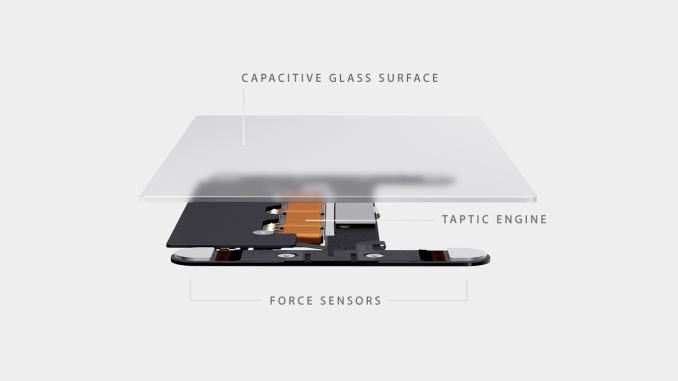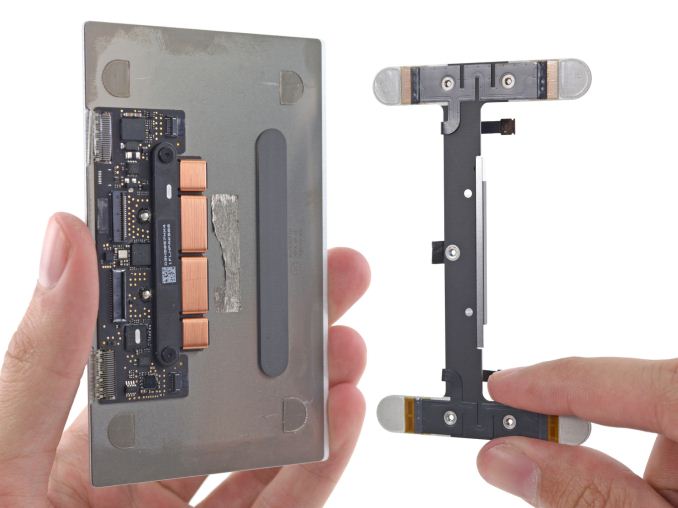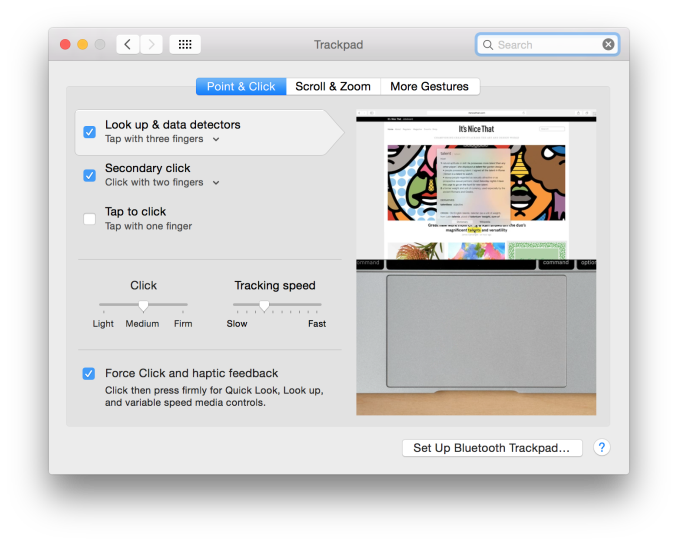The 2015 MacBook Review
by Ryan Smith on April 14, 2015 10:15 AM ESTForce Touch Trackpad
Along with Apple’s changes to their keyboard, the company has also gone in and significantly reworked their trackpad. The new Force Touch Trackpad represents the biggest change to Apple’s trackpad design since the creation of the capacitive, multi-touch pivoting trackpad introduced on the unibody MacBook Pro. In putting together the Force Touch Trackpad, Apple has significantly reworked the internals of the trackpad, creating a trackpad that behaves a lot like their traditional trackpad with some new features, but under the hood relies on some very different mechanisms.
The big change here is that Apple has done away with the traditional pivot and switch mechanism. With pivot and switch, the capacitive trackpad surface would act like a small touchscreen, and underneath it was a switch to register when the trackpad was pressed down. Mechanically the trackpad pivoted from the top (Apple likes to compare it to a diving board), with the trackpad inferring what action to take based on the combination of the capacitive readings and the switch reading. Multi-finger gestures would rely solely on the capacitive layer, primary/secondary clicks would be based on the number of fingers in use when the switch was actuated, etc.
The Force Touch Trackpad on the other hand eliminates the pivot and switch mechanism in favor of a combination of an electromagnet and force/pressure sensors. The pressure sensors essentially replace the physical switch, allowing the trackpad to tell when it has been pressed based on the amount of pressure, and thanks to the pressure sensors it can now tell how hard it has been pressed as opposed to the binary nature of the physical switch. Meanwhile without a physical switch in place to provide the clicking sensation and feedback of pressing down on the touchpad, Apple’s electromagnet – the Taptic Engine – activates to simulate the feeling and noise of pressing a switch.
Update 04/15/2015: iFixit has a great shot of the trackpad's internals, including a good look at just how big the electromagnet/taptic engine really is.
The end result is that the MacBook’s trackpad is among the first wave of devices that ships with Apple’s next generation trackpad and the enhanced capabilities that go with it. Ignoring the pressure sensitivity for a moment (we’ll get back to it), replacing the pivot and switch for an electromagnet works shockingly well. From a touch & feel standpoint the Force Touch Trackpad feels virtually identical to a traditional trackpad, to the point where it’s more than a bit uncanny. In practice you are not actually triggering a switch nor is the trackpad really moving (technically it’s deforming ever so slightly), but it sure feels like you’re working a switch. Apple has clearly done their homework on getting an electromagnet to emulate a switch, to great results. Meanwhile they don’t have the trackpad’s acoustics precisely matching a switch, but the resulting pinball-machine like plunk is close enough to a click that I don’t imagine anyone will mind the difference.
One side benefit of this change is that the trackpad feels the same throughout, and unlike the pivoting trackpad does not require more or less force depending on where you are relative to the pivot point. The variable force required has never been a major problem in my experience, but it is nice to no longer need to worry about where your fingers are relative to the top, and consequently how much force you need to use.
However the bigger deal is that by making the amount of force required to click consistent throughout the entire trackpad, Apple can now use the amount of pressure applied as another input, making the trackpad pressure-sensitive. The underlying pressure sensors and electromagnet are by default programmed to have two levels of feedback – a shallower press is equivalent to a click – and a deeper press brings about the pressure-sensitive “Force Click.” What force clicking does depends on the application, and right now it’s clear that Apple is still experimenting with what they can do with pressure sensitivity. The most obvious uses include line thickness in drawing applications, but the company is also using it for things such as variable speed fast forward and rewinding in QuickTime/iMovie. At times the force click is treated like a 3rd (tertiary) click, and other times the result is based on variable pressure. Since this is a new (and uncommon) feature there’s no global action assigned to the force click – nor does it behave as a middle click on a regular mouse – so what happens is up to the application.
In implementing force click and the Force Touch Trackpad, Apple does offer the ability to control the amount of pressure required and whether force click is active. With force click deactivated the trackpad behaves more or less identical to a traditional trackpad with a single click level. Meanwhile the click pressure setting is interesting, though I’m not entirely convinced it’s all that effective. Short of the tools to actually measure click pressure, I’m not so sure Apple is changing the amount of pressure required to trigger a click so much as they’re changing how hard the electromagnet vibrates. The feedback change is certainly very subtle going from light to firm, and if there is a change in the amount of pressure required then it is certainly equally subtle.
Ultimately whether the Force Touch Trackpad is a major upgrade or not is going to depend on a user’s ability to make use of the force click features. Even turned off, the new trackpad is essentially an improved version of the old trackpad without the minor drawbacks of the pivot mechanism. But with the force click turned on, then it brings new (though not always useful) actions to the trackpad that in turn makes it a bigger upgrade over the old trackpad.
In any case, the MacBook along with the 2015 MacBook Pro 13” are the first wave of devices to implement the new Force Touch Trackpad. Given its expanded capabilities I would expect Apple to eventually replace many (if not all) of their trackpads with this new design. Certainly the 15” MacBook Pro is a likely candidate, as is a future version of the Magic Trackpad. What remains to be seen is whether the next MacBook Air also gets this new trackpad, or if Apple withholds it to keep the products differentiated and to keep the costs of the MacBook Air down.














354 Comments
View All Comments
Silma - Wednesday, April 15, 2015 - link
For those who value silence / fanless design / ultra thinness above all else.stephenbrooks - Wednesday, April 15, 2015 - link
Let me fix some of paragraph 3..."Though Apple’s device is distinctly a laptop in terms of form factor and design, you’d none the less be excused for mistaking it for a large form factor tablet if you took a look at its overall size, rectangular shape and don't know what a laptop is."
"Apple is not doing any kind of interesting 2-in-1 transforming design, or even pushing the concept of a touchscreen OS X device." [End of paragraph]
name99 - Wednesday, April 15, 2015 - link
Re power cables and magsafe:I see two possibilities here.
One is that Apple believe wireless power (in the form THEY want it) is close enough that they can accept living with a sub-optimal solution for one or two generations. What I'd consider Apple's level of wireless power would be at the least very loose alignment requirements (as opposed to the very tight placing requirements of Qi), and the ability to deliver enough power to charge anything from an Apple Watch to a MacBook Pro. A third requirement (not quite as strong) would be some level of power efficiency --- something like no more than 10% power loss over traditional charging.
If this is not a feasible solution, an alternative solution (and IMMEDIATE 3rd party opportunity) is a magsafe CABLE rather than a magsafe connector. A cable which is (perhaps) power-only, but which have a magnetic snap point near one of the USB-C ends, so that that magnetic snap point is what breaks when the cable is jerked.
nerd1 - Thursday, April 16, 2015 - link
It's entirely possible to make a breakaway USB-C power supply cable that is compatible with previous chargers. And apple decided not to make one. Why bother? It'll still sell well.solipsism - Thursday, April 16, 2015 - link
We've had wireless data in play for decades and its now extremely fast and power efficient, but you think this is about wireless power. :sigh:nerd1 - Thursday, April 16, 2015 - link
Now apple is the one of few companies that makes smartphone without wireless charging options. Nexus devices have had one built in for years, Galaxy devices had for option and now had one built in.....solipsism - Thursday, April 16, 2015 - link
1)So induction charging then, not wireless charging.2) You really think the bottom of Macs are going to be a magnetic charger. I'm not convinced, but I'm willing to hear the argument for this. What other "PCs" have this feature built in? Who makes a 3rd-party option?
milkod2001 - Thursday, April 16, 2015 - link
- based on price and very average performance this premium netbook is aimed towards bloggers on the go and content consumers with Apple brand preference.- for actual work macbook pro line or windows ulrabook is required
solipsism - Thursday, April 16, 2015 - link
Show me a netbook with an Atom processor hat has the same performance as this MacBook that you call "average performance." You can't. Core-M far exceeds Atom's capabilities.nerd1 - Thursday, April 16, 2015 - link
"The MacBook ends up being a laggard against both of our other Core M devices"And typical Bay trail has ~3K geekbench multicore score and typical Core M laptop has ~4K.